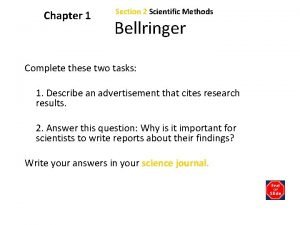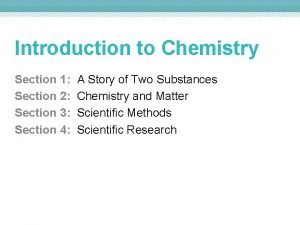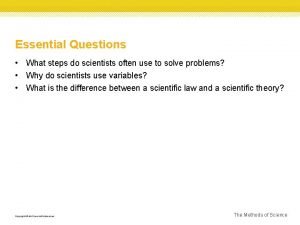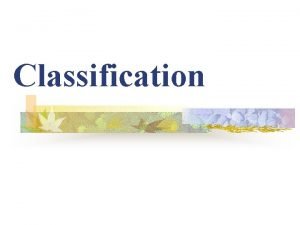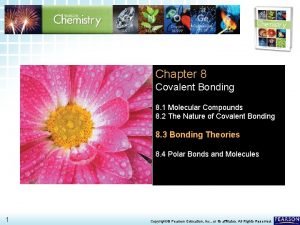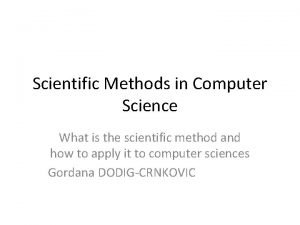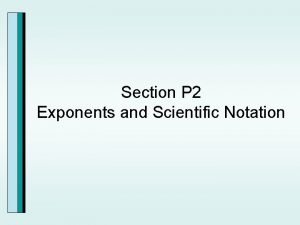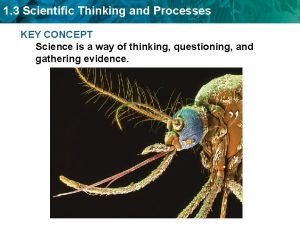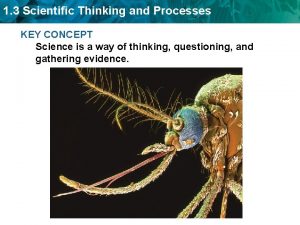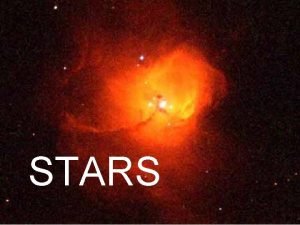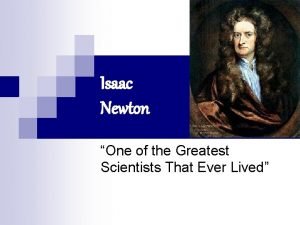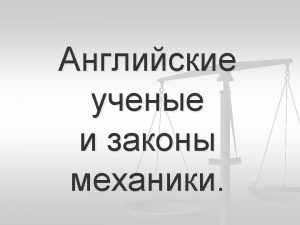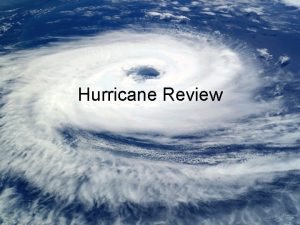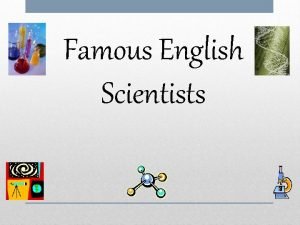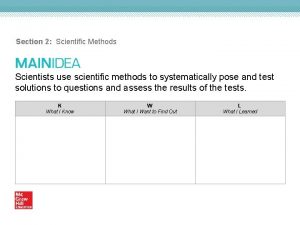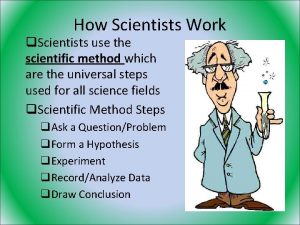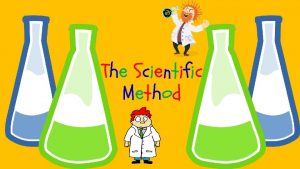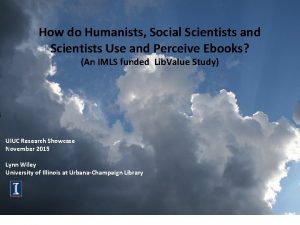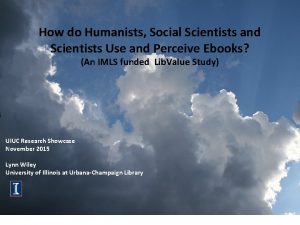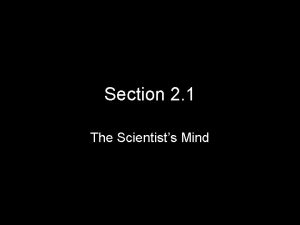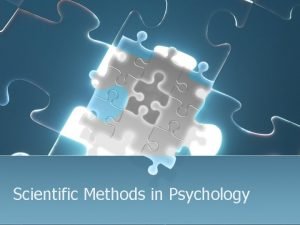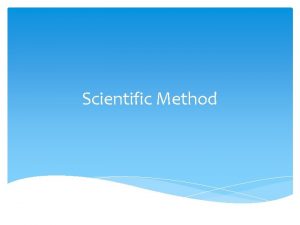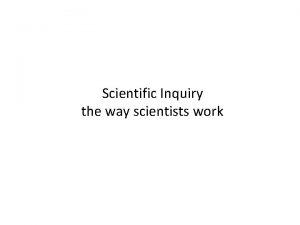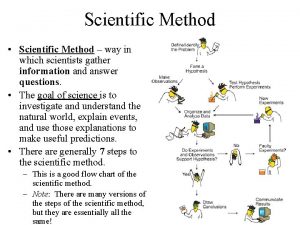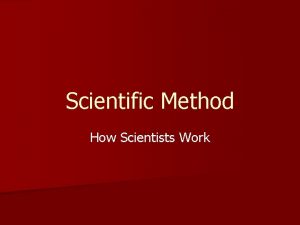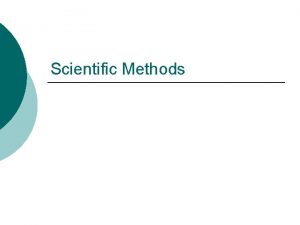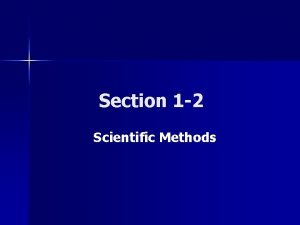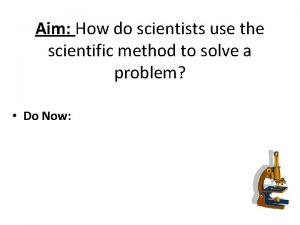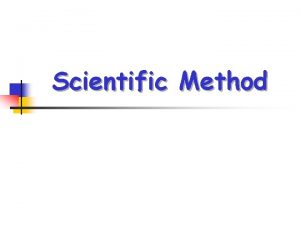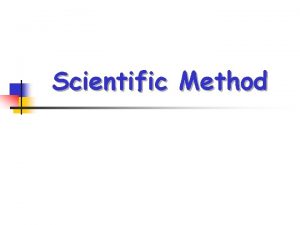Section 2 Methods of Scientists use scientific methods






















- Slides: 22

Section 2: Methods of Scientists use scientific methods to structure their experiments and investigations. K What I Know W What I Want to Find Out L What I Learned

Essential Questions • What are independent and dependent variables? • How does experimentation and investigation differ? • What are the differences between mass and weight? • What is scientific notation and how is it used? Copyright © Mc. Graw-Hill Education Methods of Scientists

Vocabulary Review New • • experiment • Copyright © Mc. Graw-Hill Education scientific methods hypothesis independent variable control Le Système International d’Unités (SI) scientific notation Methods of Scientists

The Nature of Scientific Investigations • Scientists use similar methods to gather data and communicate information. • Scientific methods are a series of problem-solving procedures that helps scientists conduct experiments. • A hypothesis is a testable explanation of a situation that can be supported or disproved by careful procedures. Copyright © Mc. Graw-Hill Education Methods of Scientists

Visualizing Scientific Methods • Scientific methods are used by scientists to help organize and plan their experiments and investigations. Copyright © Mc. Graw-Hill Education Methods of Scientists

Visualizing Scientific Methods Concepts In Motion FPO Add link to Animation from page 11 here. Copyright © Mc. Graw-Hill Education Methods of Scientists

Scientific Methods Brain. POP FPO Add link to Brain. POP here. Copyright © Mc. Graw-Hill Education Methods of Scientists

The Nature of Scientific Investigations Experimentation • An experiment is classified as an organized procedure that involves making observations and measurements to test a hypothesis. Copyright © Mc. Graw-Hill Education Methods of Scientists

The Nature of Scientific Investigations • • • The independent variable in an experiment is the factor that is changed by the experimenter. A dependent variable is a factor that is affected by changes in the independent variable. A control is used in an experiment to show that the results of an experiment are a result of the condition being tested. Copyright © Mc. Graw-Hill Education Methods of Scientists

How is a controlled experiment performed? Virtual Lab FPO Add link to Virtual Lab here. Copyright © Mc. Graw-Hill Education Methods of Scientists

The Nature of Scientific Investigations Investigation • An investigation involves observation and collecting data but does not include a control. Copyright © Mc. Graw-Hill Education Methods of Scientists

The Nature of Scientific Investigations Analysis and conclusions • During a scientific experiment, all data are carefully recorded. • Once an experiment is complete, graphs, tables, and charts are commonly used to display data. • These data are then analyzed so that a conclusion can be drawn. Copyright © Mc. Graw-Hill Education Methods of Scientists

The Nature of Scientific Investigations Analysis and conclusions • Many times, a conclusion does not support the original hypothesis. • In such a case, the hypothesis must be reevaluated and further research must be conducted. Copyright © Mc. Graw-Hill Education Methods of Scientists

Measurement • Le Système International d’Unités (SI) is a modern version of the metric system based on a decimal system. Copyright © Mc. Graw-Hill Education Methods of Scientists

Measurement Length • The SI unit for length is the meter (m). Mass • The amount of matter in an object is called mass. • The SI unit of mass is the kilogram (kg). Copyright © Mc. Graw-Hill Education Methods of Scientists

Measurement Weight • Weight is a measure of the gravitational force on an object. • The SI unit force is the newton (N). Copyright © Mc. Graw-Hill Education Methods of Scientists

Measurement Area and volume • Area is the amount of surface included within a set of boundaries. • The SI unit for area is square meters (m 2). • Volume is the amount of space occupied by an object. • The SI unit for volume is cubic meters (m 3). Copyright © Mc. Graw-Hill Education Methods of Scientists

Measurement Density • Density is the measure of the amount of matter that occupies a given space. • The SI units for density are expressed in grams per cubic centimeter (g/cm 3), grams per milliliter (g/m. L), and kilograms per cubic meter (kg/m 3). Copyright © Mc. Graw-Hill Education Methods of Scientists

Measurement Time • Time is the interval between two events. • The SI unit for time is the second (s). Copyright © Mc. Graw-Hill Education Methods of Scientists

Measurement Temperature • Temperature is a measure of the average kinetic energy of the particles that make up a material. • The SI unit for temperature is the kelvin (K). • Absolute zero is the coldest possible temperature. Copyright © Mc. Graw-Hill Education Methods of Scientists

Scientific Notation • In scientific notation, a number is expressed as a value between 1 and 10 multiplied by a power of 10. Examples • The number of grains of sand on Earth is approximately 4, 000, 000, 000 and would be written as 4 × 1021. • The mass of Earth at 5, 973, 600, 000, 000 kg would be written as 5. 9736 × 1024 kg. Copyright © Mc. Graw-Hill Education Methods of Scientists

Review Essential Questions • What are independent and dependent variables? • How does experimentation and investigation differ? • What are the differences between mass and weight? • What is scientific notation and how is it used? Vocabulary • • scientific methods hypothesis independent variable Copyright © Mc. Graw-Hill Education • control • Le Système International d’Unités (SI) • scientific notation Methods of Scientists
 Scientific methodswhat is a hypothesis?
Scientific methodswhat is a hypothesis? Introduction to chemistry section 3 scientific methods
Introduction to chemistry section 3 scientific methods Sig figs with decimals
Sig figs with decimals What steps do scientists often use to solve problems?
What steps do scientists often use to solve problems? Why do scientists classify living things?
Why do scientists classify living things? Bond 8 generacji
Bond 8 generacji Scientific inquiry vs scientific method
Scientific inquiry vs scientific method How is a scientific law different from a scientific theory?
How is a scientific law different from a scientific theory? Scientific methods in computer science
Scientific methods in computer science Tera scientific notation
Tera scientific notation Direct and indirect wax pattern
Direct and indirect wax pattern The scientific revolution chapter 6 section 1
The scientific revolution chapter 6 section 1 Section p.2 exponents and scientific notation
Section p.2 exponents and scientific notation Scientific thinking and processes
Scientific thinking and processes Section 3 scientific thinking and processes
Section 3 scientific thinking and processes Scientists recently discovered that rocks collected
Scientists recently discovered that rocks collected How do scientists classify stars?
How do scientists classify stars? Sometimes scientists make a mistake or
Sometimes scientists make a mistake or Isaac newton one of the greatest scientists was born
Isaac newton one of the greatest scientists was born Newton one of the greatest scientists
Newton one of the greatest scientists At the periphery of a hurricane, the air is ____.
At the periphery of a hurricane, the air is ____. Famous german scientists
Famous german scientists Famous english scientists
Famous english scientists
